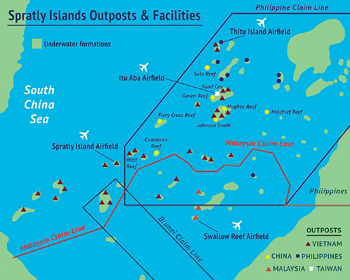INDIAN ARMED FORCES CHIEFS ON
OUR RELENTLESS AND FOCUSED PUBLISHING EFFORTS

SP Guide Publications puts forth a well compiled articulation of issues, pursuits and accomplishments of the Indian Army, over the years

I am confident that SP Guide Publications would continue to inform, inspire and influence.

My compliments to SP Guide Publications for informative and credible reportage on contemporary aerospace issues over the past six decades.
China's Strategic Expansion
In the recent years, China has embarked on consolidating her control over the South China Sea, an area over which she claims indisputable sovereignty
 | By Air Marshal B.K. Pandey (Retd) Former Air Officer Commanding-in-Chief of Training Command, IAF |
Imagery obtained through aerial reconnaissance, released into the public domain by the Centre for Strategic and International Studies in Washington, indicates activities by the People’s Republic of China to build airfields on Mischief Reef and Subi Reef, islands created artificially by her in the areas of the Spratly Islands that are located West of the Southern coast of the Philippines. Endowed with huge oil and gas reserves, the Spratly Islands are already embroiled in an ongoing territorial dispute amongst a number of nations including China, Vietnam, the Philippines, Malaysia, Taiwan and Brunei.
In the recent years, China has embarked on consolidating her control over the South China Sea, an area over which she claims indisputable sovereignty. Her efforts in this direction include a sizeable land reclamation project in the South China Sea as part of which, China has created five artificial islands with full-fledged airfield infrastructure planned to be set up on three of these. When operational, these airfields would be capable of operating most, if not all, the military aircraft that China has on her inventory. Last year, China took the world by surprise when she proclaimed navigational control in the skies over large parts of the South China Sea that lies between her coastline and Japan. China went on to declare the air space over this area as an Air Defence Identification Zone (ADIZ). In effect, this step by China meant that the South China Sea was Chinese territory and that the air space over it was under Chinese control. Aircraft of other nations, civil or military, would therefore need prior clearance from China’s air defence control agency for operating in or through the ADIZ.

Quite understandably, there is growing concern amongst all the nations of the region about China’s drive to militarise the South China Sea to dominate the region. Benigno Aquino, the President of the Philippines, while addressing the Japanese Parliament during his visit to Tokyo in June this year, commented on the aggressive expansionist inclinations of China. He drew a parallel between present-day China to Nazi Germany. He even stated that “the world cannot continue to appease Beijing as it claims ever more territory in the South China Sea”. China of course, claims that the new islands would be used for humanitarian, environmental, fishing and other purposes. She brushes aside objections from the US and Australia pointing out that Vietnam and Malaysia have also been engaged in land reclamation in the South China Sea which have not been objected to by the US.
Apart from the huge oil and natural gas reserves, owing to its location, the South China Sea is of immense strategic importance not only for the countries in the region, but also for all the leading maritime nations of the world as it is a major shipping corridor through which passes trillions of dollars worth of trade. The nations whose economies are inexorably linked to trade through sea lanes of communication, would naturally like to see that freedom of navigation through the South China Sea is not curtailed in any way. Recent moves by China that are regarded as provocative by most nations, does not inspire any confidence or comfort in this regard. India’s interest goes beyond sea trade to exploration for oil jointly with Vietnam in their exclusive economic zone about which China has serious reservations.
China’s actions would be of serious concern to the US as these would have implications for its broader strategy of ‘pivot’ in the Asia-Pacific region. The revelation of Chinese aggressive intent has come practically on the eve of the very first state visit to the US by Xi Jinping, the President of China. A statement issued by the White House says, “President Xi Jinping’s visit will present an opportunity to expand cooperation between the US and China on a range of global, regional and bilateral issues of mutual interest, while also enabling President Obama and President Xi Jinping to address areas of disagreement constructively”. Apart from the allegations by the US against China related to ‘cyber espionage’, President Obama will undoubtedly convey his concerns on China’s increasing assertiveness in the disputed waters of the South China Sea. Response by President Xi Jinping to US concerns will be a clear indicator of things to come.





